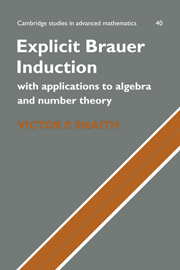2 - Induction theorems
Published online by Cambridge University Press: 12 January 2010
Summary
Introduction
The chapter concerns induction theorems; that is, theorems which express arbitrary representations as linear combinations of induced representations within the representation ring, R(G), tensored with a suitable ring of coefficients.
We begin the chapter with a proof of Brauer's canonical form for Artin's Induction Theorem. Artin's result, in this form, gives a canonical rational form for the identity representation within R(G) ⊗ Q, the rationalised representation ring, in terms of representations which are induced from cyclic groups. By Frobenius reciprocity Artin's theorem yields a similar rational canonical form for any representation. Brauer's Induction Theorem, in its original (non-canonical) form states that any representation can be expressed as an integral linear combination of representations which are obtained by induction from one-dimensional representations of elementary subgroups. This celebrated result has been proved by a variety of methods, to which we add a new topological proof here. This proof involves replacing the given representation of G by the unique, equivalent, unitary representation and using the latter to perform some elementary algebraic topology on the resulting action of G on the compact manifold given by the unitary group modulo the normaliser of its maximal torus. This topological proof of the existence part of Brauer's theorem was the basis of the first derivation of a canonical form for Brauer's theorem, which appeared in Snaith (1988b). This topologically derived canonical form possessed two important properties: namely, of naturality and of being the identity on one-dimensional representations.
- Type
- Chapter
- Information
- Explicit Brauer InductionWith Applications to Algebra and Number Theory, pp. 23 - 71Publisher: Cambridge University PressPrint publication year: 1994

